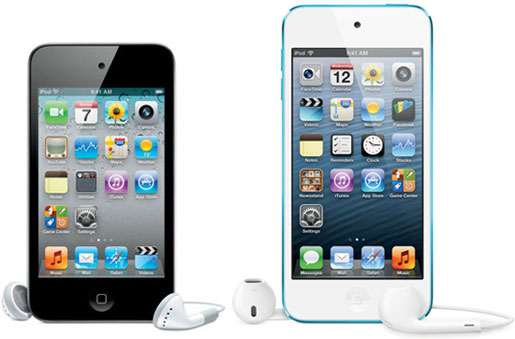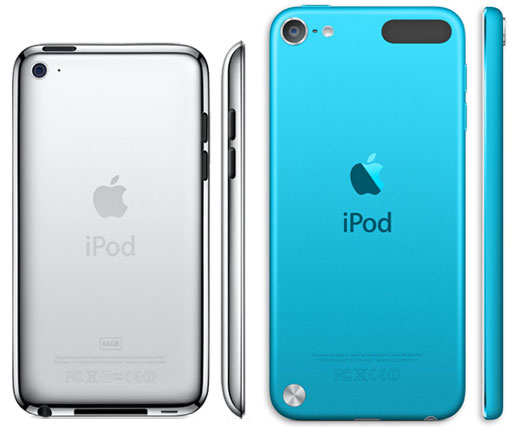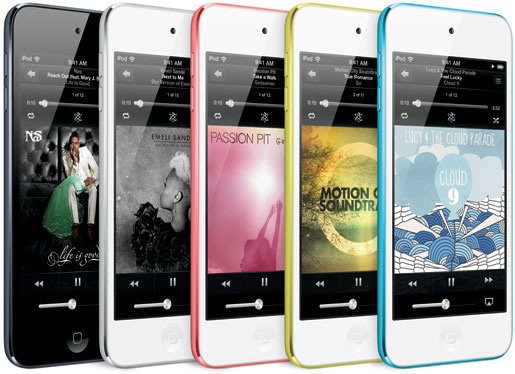Hosted by site sponsor WebMate.
iPod touch Q&A - Updated July 11, 2016
All Apple Q&As >> iPod touch Q&A (Home)
To be notified of new Q&As, sign up for EveryMac.com's bimonthly email list.
What are all the differences between the iPod touch 4th Generation (A1367) and iPod touch 5th Generation (A1421/A1509)?
Please note that all iPod touch 4th Generation and iPod touch 5th Generation models have been discontinued. However, this Q&A has been updated with current iOS support details for both lines and it can be quite helpful for anyone buying or selling one of these models on the used market. Everyi.com also compares the iPod touch 5 and iPod touch 6.
With even the most cursory of glances at any of the iPod touch 4th Generation models -- whether from 2010, 2011, or 2012 -- and an iPod touch 5th Generation -- whether the 16 GB or 32 GB and 64 GB configurations with colorful case options or the "low end" 16 GB configuration only in black and silver (and no rear camera) -- it is immediately apparent that the iPod touch 5th Generation models have a larger display and a different housing.
However, there are many other differences that merit detailed evaluation, too.

Photo Credit: Apple, Inc. (iPod touch 4th Gen - Left, 5th Gen - Right)
iPod touch 4th Gen (2010-2012) & 5th Gen Differences (2012-2014)
As noted above, there are three different lines of iPod touch 4th Generation models and three different iPod touch 5th Generation releases, as well.
The iPod touch 4th Generation lines essentially vary only by the amount of capacity, whether it only was offered in black or also offered in white, and by the introductory price.
The three iPod touch 5th Generation models -- the original 32 GB and 64 GB configurations, the "low end" 16 GB configuration introduced in 2013, and the final entry-level 16 GB configuration introduced in 2014 -- have more significant differences.
Apart from capacity, pricing, and other minor identifier differences, the final entry-level 16 GB and higher-end original 32 GB and 64 GB configurations vary only by the iPod touch loop. Specifically, the higher-end configurations included this iPod touch loop (wrist strap) whereas the accessory could be purchased for an additional US$9 (C$9, £7, and A$12 in Canada, the UK, and Australia, respectively) for the entry-level model.
By contrast, the "low end" 16 GB model only was offered in silver and lacks both the rear mounted "iSight" camera and the ability to attach the "iPod touch loop" entirely. It has other minor cosmetic differences and different identifiers, as are enumerated below, too.
Although Everyi.com's Ultimate iLookup feature can uniquely identify each of these iPod devices by their Serial Numbers, all of the relevant models are subsequently referenced simply as the 4th Gen and 5th Gen, respectively, for the purpose of this Q&A unless the differences merit specific mention.
External & Camera Differences
Perhaps the most obvious difference between the iPod touch 4th Gen and 5th Gen is that the 5th Gen devices have a 4" (diagonal) widescreen display with a 1136x640 native resolution and the 4th Gen have a smaller 3.5" display with a 960x640 native resolution. Both displays are considered to be "Retina" quality (326 ppi), but the 5th Gen display is IPS and has a better viewing angle.
The design of the two devices themselves also varies significantly. The iPod touch 4th Gen models have either a white or black glass front and a chromed metal back with sides that taper quickly toward the rear, which makes it feel quite thin. The iPod touch 5th Gen models still have a white or black glass front, but by contrast, use anodized aluminum "unibody" cases with only slightly rounded sides, which when combined with the larger display, make the device "feel" a bit larger than the iPod touch 4th Gen even though it is slightly thinner.

Photo Credit: Apple, Inc. (iPod touch 4th Gen - Left, A1421 5th Gen - Right)
Rather than just white or black, the iPod touch 5th Gen models were offered in a number of color choices. Specifically, the final entry-level 16 GB and original 32 GB and 64 GB configurations were available in six different colors -- gray, silver, pink, yellow, blue, and red. The gray option has a black front whereas all other colors -- silver, pink, yellow, blue, and red -- have white fronts.
For those really interested in tiny details, the 32 GB and 64 GB configurations originally were offered in a dark gray "slate" and this was switched to a medium colored gunmetal "space gray" starting September 10, 2013. The subsequently introduced 16 GB configuration only was available in space gray.

Photo Credit: Apple, Inc. (iPod touch 5th Gen -- 32 GB & 64 GB Color Options)
By contrast, the low-end 16 GB iPod touch 5th Gen (A1509) only was offered in silver, but it has a black front rather than a white one like the other models in silver (and as mentioned previously this low-end model lacks the option of the iPod touch loop entirely). It also has cheaper black plastic volume control and on/off buttons -- like the iPod touch 4th Gen -- rather than aluminum ones like the higher-end iPod touch 5th Gen configurations.

Photo Credit:
Apple, Inc. (iPod touch 5th Gen: A1421 Left; A1509 Right/No Rear Camera)
The cameras also are notably different. The iPod touch 4th Gen has two cameras -- a front-mounted VGA quality "FaceTime" camera and a rear-mounted 720p camera that can take 960x720 still photos (roughly 0.7 megapixels).
The final entry-level 16 GB and original 32 GB and 64 GB configurations of the iPod touch 5th Gen also have two cameras, but they're higher quality -- a front-mounted 720p "FaceTime HD" camera that takes 1.2 megapixel photos and a rear 5 megapixel 1080p "iSight" camera. This "iSight" camera also provides autofocus, backside illumination, a hybrid HR filter, a five-element lens, and an LED flash as well as Panorama and HDR support. The low-end 16 GB iPod touch 5th Gen (A1509) has the front-mounted 720p "FaceTime HD" camera, but it does not have a rear camera at all.
Take a quick peek at the bottom of the devices, and you will immediately notice that the iPod touch 4th Gen models have the traditional long and thin iPod "Dock Connector" port whereas the iPod touch 5th Gen models have the smaller and reversible "Lightning" port and a larger, and slightly clearer speaker. The iPod touch 5th Gen models also are equipped with revised earphones that Apple refers to as "EarPods" and that provide better noise reduction and a bit "snugger" fit for most people's ears, but they do not have the integrated microphone and inline remote.
Identification Differences
Although the larger display, "unibody" design, and port type -- and whether or not the device has a rear camera -- make the iPod touch 5th Gen models easy to spot when side-by-side with the iPod touch 4th Gen, specific identifiers still can be helpful for precision when the devices are not side-by-side.
The most certain way to externally identify the iPod touch 4th Gen and 5th Gen models is by the Model Number in small type on the back of each device toward the bottom, although it can be quite hard to read on the iPod touch 4th Gen models, particularly if the device has been scratched.
Nevertheless, all iPod touch 4th Gen devices share model number A1367, the 16 GB and 32 GB and 64 GB iPod touch 5th Gen models with a rear camera share model number A1421, and the low end 16 GB iPod touch 5th Gen without a rear camera is model number A1509.
Everyi.com's Ultimate iLookup feature also can identify these iPod models by EMC Number and Order Number (launch the Settings app and then select General > About and finally scroll down to what is referred to as "Model" in the iOS). For example, the 32 GB configuration of the iPod touch 5th Gen in black and slate is MD723LL.
Both the site and EveryMac app additionally can identify these devices by their Serial Numbers, as well.
Internal Differences
Internally, the iPod touch 4th Gen and iPod touch 5th Gen essentially are completely different.
The iPod touch 4th Gen has a variable speed 1 GHz Apple A4 processor and 256 MB of RAM as well as support for 802.11b/g/n Wi-Fi (only the 2.4 GHz frequency of 802.11n) and Bluetooth 2.1+EDR. It provides an estimated 40 hours of music playback and 7 hours of video playback.
The iPod touch 5th Gen models, on the other hand, have a faster 1 GHz dual-core A5 processor and 512 MB of RAM as well as support for 802.11a/b/g/n (including both the 2.4 GHz and 5 GHz frequencies of 802.11n) and Bluetooth 4. It provides the same 40 hours of estimated music playback, but 8 hours of video playback.
iOS Support & Software Differences
iOS support also is a major point of differentiation. The iPod touch 4th Gen models only are partially supported by iOS 6. Most notably, when running iOS 6, the iPod touch 4th Gen models do not support Maps, Siri, Panorama, and FaceTime over cellular. They are not supported by iOS 7 or subsequent versions of the iOS at all, which was particularly upsetting to some users as the device was sold as new a mere eleven days before iOS 7 was announced.
The iPod touch 5th Gen models, by contrast, are fully supported by iOS 6, iOS 7, and iOS 8. The devices are supported by iOS 9, as well. However, they are not supported by iOS 10.
Comparison Chart
For your convenience, the primary differences between the iPod touch 4th Gen and the iPod touch 5th Gen are summarized below:
 iPod touch 4th Gen (2010, 2011, 2012) |
 iPod touch 5th Gen (2012, 2013, 2014) |
|
|---|---|---|
| Display: | 960x640 (326 ppi) | 1136x640 (326 ppi) |
| Cameras: | VGA 720p (0.7 MP) |
720p (1.2 MP) None/1080p (5 MP)* |
| LED Flash: | No | Yes |
| Five Element Lens: | No | Yes |
| Processor Speed: | 1 GHz | 1 GHz |
| Processor Type: | Apple A4 | Apple A5 |
| Processor Cores: | Single | Dual |
| RAM: | 256 MB | 512 MB |
| Storage Size: | 8, 16, 32, 64 GB | 16, 32, 64 GB |
| Wi-Fi: | 802.11b/g/n | 802.11a/b/g/n |
| Bluetooth: | 2.1+EDR | 4 |
| Connectivity: | Dock Connector | Lightning |
| Battery Life (Music): | 40 Hours | 40 Hours |
| Battery Life (Video): | 7 Hours | 8 Hours |
| iOS 6 Support: | Partial | Complete |
| iOS 7- iOS 9 Support: | None | Complete |
| iOS 10 Support: | None | None |
| Color Options: | White/Black | Multiple Colors |
| Dimensions (Inches): | 4.3 x 2.4 x 0.33 | 4.86 x 2.31 x 0.24 |
| Weight (Ounces): | 3.56 oz. (101 g) | 3.10 oz. (88 g) |
| Model Number: | A1367 | A1421/A1509 |
| Original Price (US): | US$229, US$299, US$399† | US$229, US$299, US$399§ |
* The 16 GB and 32 GB and 64 GB configurations (A1421) of the iPod touch 5th Gen have two cameras. The 16 GB configuration (A1509) has the front-mounted 720p "FaceTime HD" camera, but it does not have a rear camera at all.
† The first 2010 iPod touch 4th Gen models -- with 8 GB, 32 GB, and 64 GB of storage -- originally sold for US$229, US$299, and US$399, respectively. The 2011 iPod touch 4th Gen models, with the same capacity, sold for US$199, US$299, and US$399. Finally, the 2012 iPod touch 4th Gen models -- with 16 GB or 32 GB of storage -- sold for US$199 and US$249.
§ The 16 GB configuration that lacks the iSight camera was US$229. The 32 GB and 64 GB configurations were originally US$299 and US$399, respectively. The final entry-level 16 GB (A1421) configuration was US$199, US$249, and US$299, respectively.
Should I buy an iPod touch 4th Gen or 5th Gen?
Ultimately, although a newer device would be best for most users, just compared to one another, the iPod touch 5th Gen models provide a better and bigger display, better cameras (or at least a better camera for the low-end 16 GB model), faster performance, and more modern iOS support (albeit not current iOS support), and are the better choice for most people as a result.
If the iPod touch 4th Gen display, cameras, and performance meet your needs, keep in mind that app support largely has faded for iOS 6, and depending on your interest in apps, this may be a major limitation of the device. However, for those who want to save money, it remains worth consideration, particularly given lower prices on the used market. At a minimum, the iPod touch 4th Gen will remain a useful music player of locally stored music for some time.
iPod touch Purchase Options
There are many places to buy a used iPod touch. However, buying from a quality company with extensive iPod knowledge -- and after sales support -- will provide the best experience and save you money and time, too.
To dynamically compare any iPod touch model to all other iPod, iPhone, and iPad models -- new and old alike -- please see Everyi.com's Ultimate iComparison feature.
Permalink | Report an Error/Typo | Sign Up for Site Update Notices
Established in 1996, EveryMac.com has been created by experts with decades of experience with Apple hardware. EveryMac.com includes, and always has included, original research incorporating detailed, hands-on inspection of packaging, computers, and devices as well as extensive real-world use. All information is provided in good faith, but no website or person is perfect. Accordingly, EveryMac.com is provided "as is" without warranty of any kind whatsoever. EveryMac.com, and the authors thereof, shall not be held responsible or liable, under any circumstances, for any damages resulting from the use or inability to use the information within. For complete disclaimer and copyright information please read and understand the Terms of Use and the Privacy Policy before using EveryMac.com. Copying, scraping, or use of any content without expressed permission is not allowed, although links to any page are welcomed and appreciated.
